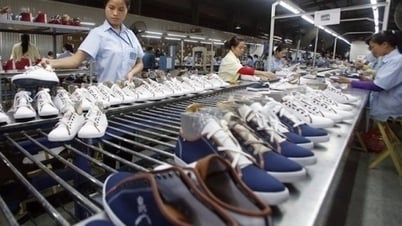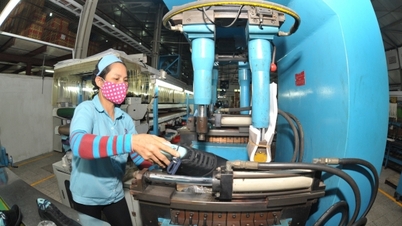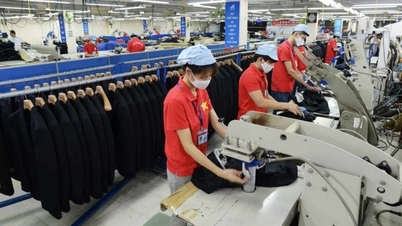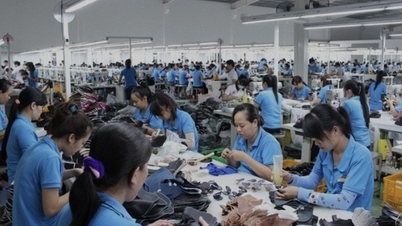To achieve the goal, the Vietnamese footwear industry continues to expand and diversify its markets, while focusing on maintaining traditional markets such as the US and EU due to their large purchasing power and market capacity.

Production of shoes for export to EU market.
The Vietnam Leather, Footwear and Handbag Association (Lefaso) forecasts that the industry's export turnover in 2024 will reach about 26-27 billion USD.
To achieve the above goal, in 2024, the Vietnamese leather and footwear industry will continue to expand and diversify its markets, while focusing on maintaining traditional markets such as the US and EU due to their large purchasing power and market capacity, and especially promoting exports to markets with FTAs.
Ms. Phan Thi Thanh Xuan, Vice President and General Secretary of the Vietnam Leather, Footwear and Handbag Association, said that businesses are continuously recruiting workers to speed up production after a period of downsizing. In terms of product segments, Vietnam is assessed to be able to produce footwear products of average quality and high difficulty.
In the coming time, the footwear industry will not focus on producing low-value products because of low profits and waste of resources, but will continue to focus on the mid- and high-end product segments.
In the first 6 months of 2024, Vietnam's leather and footwear export turnover reached over 6.5 billion USD, an increase of 5.7% over the same period in 2023.
According to Ms. Xuan, for export markets, the footwear industry still focuses on 5 main markets. The US accounts for the largest proportion of about 35%, followed by the EU at 26%, Japan and South Korea.
China alone currently accounts for 9% of the proportion and turnover is increasing day by day. This is also a market that helps the leather and footwear industry have room for export growth in 2024.
Experts believe that major economies are also potential export markets for the Vietnamese footwear industry, with growth expected in 2024. In particular, Vietnam has some significant competitive advantages over other countries that produce and export footwear and handbags. Vietnam is a country with many free trade agreements, accounting for more than 60% of global trade volume.
Currently, Vietnam has more than 1,000 shoe factories and creates jobs for about 1.5 million workers, contributing about 8% of the country's GDP.
In particular, in the Southwest and Central regions of Vietnam, there are still many workers, cheap labor costs, large vacant land areas... This is an opportunity for Vietnamese enterprises to continue to develop, while attracting foreign investors to Vietnam's leather and footwear industry.
Ms. Phan Thi Thanh Xuan said that some green standards and sustainable development such as policies on ecological products, extended responsibility to manufacturers, traceability of supply chains... can be applied by Vietnam's major footwear import markets this year and in the next few years will affect the industry's exports. Ms. Xuan said that compliance is mandatory.
Regarding the carbon pricing mechanism (CBAM), Ms. Xuan said that footwear is an industry that is assessed to cause large emissions during the production process, so it is also among the subjects affected by CBAM. The EU is currently a large export market for Vietnam, about 6 billion Euros per year, so it is necessary to prepare for changes and respond to this regulation.
To do this, businesses must first thoroughly understand the information and processes to meet and comply with CBAM. In addition, they need to prepare large resources in terms of human resources, technology, and finance to meet CBAM.
Therefore, businesses cannot go out into the open sea alone, but need to participate in better network activities to grasp information, have deeper and better preparation plans, learn and gain experience to be able to successfully meet regulations and participate in the supply chain.
According to Ms. Phan Thi Thanh Xuan, businesses need to apply digital transformation in management so that the data flow in the factory is continuous, helping leaders update information and make timely decisions. In particular, businesses need to focus on building a compliance department. This department updates information about customer requests to accurately transfer to the production system.
Furthermore, leather and footwear businesses need to make good use of free trade agreements.
Because, especially in the bloc of markets with the Vietnam-EU Free Trade Agreement, the Comprehensive and Progressive Agreement for Trans- Pacific Partnership is a fundamental factor helping the industry achieve high export turnover.
Vietnam's industrial development strategy to 2025, with a vision to 2035, issued under Decision No. 879/QD-TTg dated June 9, 2014, identified textiles and footwear as two of the seven priority industries of Vietnam.
In order to support the leather and footwear industry to develop more stably and sustainably in the coming time, the Ministry of Industry and Trade has been urging relevant units and localities to focus on effectively implementing the Strategy for the development of Vietnam's leather and footwear industry to 2030, with a vision to 2035; and building a Program for sustainable development of the leather and footwear industry for the period 2021-2030.
Source: VNA
Source: https://baophutho.vn/xuat-khau-da-giay-nam-2024-du-kien-dat-khoang-26-27-ty-usd-215297.htm


![[Photo] Prime Minister Pham Minh Chinh chairs meeting on science and technology development](https://vphoto.vietnam.vn/thumb/1200x675/vietnam/resource/IMAGE/2025/5/17/ae80dd74c384439789b12013c738a045)

![[Photo] Readers line up to visit the photo exhibition and receive a special publication commemorating the 135th birthday of President Ho Chi Minh at Nhan Dan Newspaper](https://vphoto.vietnam.vn/thumb/1200x675/vietnam/resource/IMAGE/2025/5/17/85b3197fc6bd43e6a9ee4db15101005b)
![[Photo] More than 17,000 candidates participate in the 2025 SPT Competency Assessment Test of Hanoi National University of Education](https://vphoto.vietnam.vn/thumb/1200x675/vietnam/resource/IMAGE/2025/5/17/e538d9a1636c407cbb211b314e6303fd)


























![[Photo] Nearly 3,000 students moved by stories about soldiers](https://vphoto.vietnam.vn/thumb/1200x675/vietnam/resource/IMAGE/2025/5/17/21da57c8241e42438b423eaa37215e0e)





































































Comment (0)